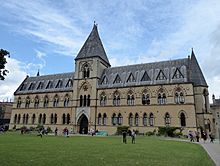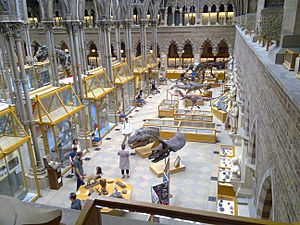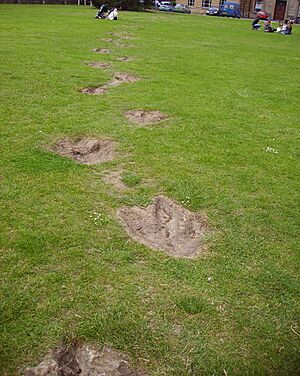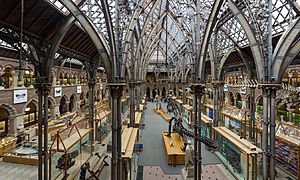Oxford University Museum of Natural History facts for kids

Front view of the museum
|
|
| Lua error in Module:Location_map at line 420: attempt to index field 'wikibase' (a nil value). | |
| Established | 1860 |
|---|---|
| Location | Parks Road, Oxford, England |
| Type | University museum of natural history |
| Collections | Natural history |
| Collection size | approx. 7 million objects |
| Visitors | 792,282 (2019) |
| Founder | Sir Henry Acland |
| Architect | Thomas Newenham Deane, Benjamin Woodward |
The Oxford University Museum of Natural History (often called OUMNH) is a cool place in Oxford, England. It shows off many of the University of Oxford's amazing natural history items. You can find it on Parks Road.
This museum also has a large lecture hall. This hall is used by the university's chemistry, zoology, and mathematics departments. It is also the only public entrance to the Pitt Rivers Museum, which is right next door.
Contents
Museum History: How It Started

In 1850, Oxford University started teaching natural science. But the classrooms and collections were spread out across the city. Sir Henry Acland, a professor of medicine, wanted to bring everything together. He started building this museum between 1855 and 1860.
The museum officially opened in 1860. However, some departments moved in as early as 1858. Acland believed the university needed to teach more about the natural world. He thought it was important to understand the "great material design" of nature.
Many of the museum's first collections came from the Ashmolean Museum. These included items gathered by John Tradescant the elder and his son, William Burchell, and geologist William Buckland. The Christ Church Museum also gave its bone and body specimens. Many of these were collected by Henry Acland himself. The money to build the museum came from selling Bibles.
Several science departments moved into the new building. These included astronomy, geology, zoology, and chemistry. As these departments grew, they moved to new buildings nearby. This area is now known as the university's Science Area.
The last department to leave the museum building was entomology (the study of insects) in 1978. But there is still an insect lab on the first floor. Between 1885 and 1886, a new building was added next to the museum. This became the Pitt Rivers Museum, holding items made by people. In the 1800s, people thought it was important to keep natural items separate from human-made ones.
The museum had big updates and changes to its layout between 2023 and 2024.
The Museum Building: A Closer Look
The museum's neo-Gothic style building was designed by Irish architects Thomas Newenham Deane and Benjamin Woodward. The famous critic John Ruskin even gave ideas during its construction. Building started in 1855 and finished in 1860.
The building next door, which houses the Pitt Rivers Museum, was built later. It was designed by Thomas Manly Deane, Thomas Newenham Deane's son. This part was built between 1885 and 1886.
The museum has a large central area with a glass roof. This roof is held up by cast iron pillars. These pillars divide the main court into three sections. Around the ground and first floors, there are covered walkways. Each stone column in these walkways is made from a different British stone. Geologist John Phillips chose these stones.
The decorations on the stone and iron pillars show natural shapes. You can see leaves and branches. This style mixes art with the building's scientific purpose.
Statues of famous scientists stand around the ground floor. These include Aristotle, Bacon, Darwin, and Linnaeus. The university paid for the building itself. But the decorations were paid for by public donations. Many of these decorations are still not finished.
Irish stone carvers named O'Shea and Whelan worked on the building. They created lively, freehand carvings. When money ran out, they offered to work for free. But some university members accused them of "defacing" the building with unapproved work. It is said that the O'Shea brothers carved university members as parrots and owls near the entrance. They were supposedly made to remove these carvings.
On January 12, 1954, both the Natural History and Pitt Rivers museums became "Grade I listed" buildings. This means they are very important and protected.
Exciting Moments at the Museum
The 1860 Evolution Discussion
A very important discussion about evolutionary biology happened here in 1860. It was during a meeting of the British Association for the Advancement of Science. People from the Church and science talked about evolution. This event is often seen as a key moment where scientific ideas gained ground.

The biologist Thomas Huxley and Samuel Wilberforce, the Bishop of Oxford, were the main speakers. Huxley was a strong supporter of Darwin's ideas. Wilberforce had supported building the museum for science. He believed it would help study God's creations.
On June 27, 1860, a botanist named Charles Daubeny talked about Darwin's theory of natural selection. Richard Owen, a zoologist, disagreed with Darwin's theory. He said that a gorilla's brain was more different from a man's than from other primates. Huxley said he would reply to this later in writing.
Rumors spread that the Bishop of Oxford would speak on the following Saturday. Huxley first planned to avoid the bishop's speech. But another evolutionist, Robert Chambers, convinced him to stay.
Wilberforce's speech on June 30, 1860, was funny and clever. But it was also an unfair attack on Darwinism. He famously asked Huxley if he was descended from a monkey through his grandfather or grandmother. Some people think Owen helped Wilberforce write this question.
When Huxley spoke, he said Wilberforce had not shown any problems with Darwin's ideas. He said Darwin's theory was still the best explanation for how species came to be. Huxley then gave his famous reply to Wilberforce's question. He said he would not be ashamed of having an ape as a grandfather. But he would be ashamed of having an ancestor who tried to distract people with fancy words and religious bias.
However, it seems the debate might not have been as dramatic as people often say. News reports from that time do not mention these exact famous quotes. Also, some accounts suggest that Joseph Dalton Hooker defended Darwinism more strongly than Huxley at that meeting.
While most stories say Darwin's supporters were more convincing, it is likely that Huxley's supporters made the debate sound more exciting. This helped gain more support for Darwin's theories.
First Wireless Signal Demonstration
The very first public showing of wireless telegraphy happened in the museum's lecture hall. This was on August 14, 1894. Professor Oliver Lodge sent a radio signal from the nearby Clarendon Laboratory. The equipment in the lecture hall received it.
Charles Dodgson and the Dodo
The museum has a painting of a dodo from 1651 by the artist Jan Savery. Charles Dodgson, known as Lewis Carroll, often visited the museum. This painting likely inspired the Dodo character in his famous book, Alice's Adventures in Wonderland.
2024 Oxford University Campus Events
On May 6, 2024, a student encampment was set up on the museum's front lawn. This was part of a series of events on the University of Oxford campus.
Museum Collections
The museum's collections are split into three main parts. The Earth Collections have Palaeontological items, minerals, and rocks. The Life Collections include zoological (animal) and entomological (insect) items. There are also Archive Collections.
The Hope Entomological Collections are huge, with over five million insect specimens. This department was started by Frederick William Hope. Many important insect and spider specimens are here. They come from famous collectors like Alfred Russel Wallace and Charles Darwin.
The Museum Today
The museum is led by a director, currently Professor M. Paul Smith. He became director in 2011. There are also staff who work with visitors, education, IT, the library, and conservation.
Since 1997, the museum has received money from outside sources. This has helped them update their displays. Besides the famous dodo and dinosaur exhibits, there are new displays in old Victorian cabinets. These cover topics like Evolution, Primates, the History of Life, and Rocks and Minerals.
You can also touch some popular items. These include two bears, a fox, and other stuffed animals. There is also a meteorite and large fossils and minerals. Visitors can see big dinosaur models and skeletons of many mammals.

In 1997, a famous group of ichnites (fossilized footprints) was found. They were in a limestone quarry near Ardley, about 20 km northeast of Oxford. People think they were made by Megalosaurus and possibly Cetiosaurus. You can see copies of some of these footprints on the museum's front lawn.
The museum's tower is a popular spot for migrating swifts to nest. Cameras have been put in place. They show a live video stream of the swifts on a display near the main entrance.
The museum closed on March 17, 2020, because of the COVID-19 pandemic. It reopened with some rules on September 22, 2020.
The giant redwood tree in front of the museum was 35.7 meters tall in 2006. It is the tallest object in central Oxford. In 2024, a lightning rod was added to the tree to protect it from lightning strikes.
See also
 In Spanish: Museo de Historia Natural de la Universidad de Oxford para niños
In Spanish: Museo de Historia Natural de la Universidad de Oxford para niños
- The Abbot's Kitchen, an old chemistry lab next to the museum.
- Museum of Oxford, which tells the history of Oxford city.
- Radcliffe Science Library, Oxford University's science library, close to the museum.






